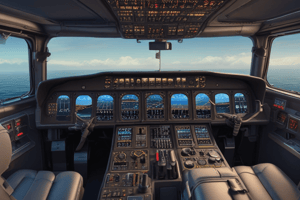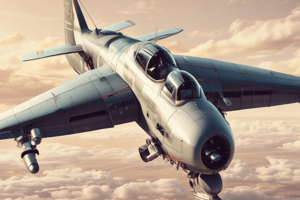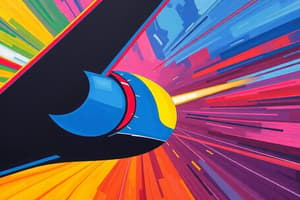Podcast
Questions and Answers
What are the secondary flight control surfaces? (Select all that apply)
What are the secondary flight control surfaces? (Select all that apply)
- Spoilers (correct)
- Leading edge devices (correct)
- Flaps (correct)
- Trim systems (correct)
What are flaps?
What are flaps?
Connected to the trailing edge of wings, raised/lowered to adjust lift/drag.
What are leading edge devices?
What are leading edge devices?
Devices that generally increase lift/drag.
What is the function of spoilers?
What is the function of spoilers?
What is the main purpose of trim systems?
What is the main purpose of trim systems?
What are the characteristics of trim systems?
What are the characteristics of trim systems?
How do pilots typically use trim systems?
How do pilots typically use trim systems?
When are control pressures generated, and when is trimming necessary?
When are control pressures generated, and when is trimming necessary?
When is trimming complete?
When is trimming complete?
Flashcards are hidden until you start studying
Study Notes
Secondary Flight Control Surfaces
- Include flaps, leading edge devices, spoilers, and trim systems.
Flaps
- Located on the trailing edge of wings, crucial for adjusting lift and drag.
- Modern aircraft flaps are retractable, allowing high-speed cruising and low-speed landings.
Leading Edge Devices
- Primarily designed to enhance lift and drag during flight.
Spoilers
- Decrease lift and increase drag, enhancing roll control and mitigating adverse yaw.
- Activating a spoiler on the side of a turn reduces lift and creates additional drag, causing the wing to drop and the aircraft to bank.
- Raising both spoilers simultaneously enables descent without a speed increase.
- Function as effective aerodynamic brakes by increasing drag and pushing the aircraft down during landing.
Trim Systems Overview
- Aim to alleviate pilot workload by maintaining desired flight attitudes without continuous control pressure.
Characteristics of Trim Systems
- Affixed to the trailing edges of primary control surfaces, commonly found on elevators in small aircraft.
- Adjustments made using a small wheel or crank located in the cockpit.
- Position of trim tabs is displayed for the pilot's reference.
- When a tab is deflected upwards, it forces the elevator downward, raising the tail and lowering the aircraft's nose.
Pilot Usage of Trim Systems
- Pilots first establish desired pitch, power settings, altitude, and aircraft configuration before utilizing trim to manage control pressures.
Trimming Requirements
- Any alteration in flight conditions generates control pressures, necessitating subsequent trimming to maintain desired performance.
Completion of Trimming
- Successfully trimmed when pilots feel no "heaviness" or control pressure in the nose or tail of the aircraft.
Studying That Suits You
Use AI to generate personalized quizzes and flashcards to suit your learning preferences.




